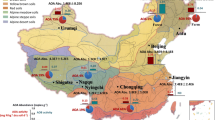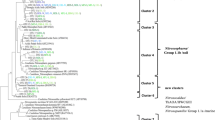Abstract
Purpose
Acidic red soils account for 21% of land area in China and contain low ammonia concentration due to ionization to ammonium. The unusual high affinity for ammonia of marine Nitrosopumilus maritimus and acidophilic soil Nitrosotalea devanaterra has suggested that ammonia-oxidizing archaea (AOA) may have greater selective advantage over ammonia-oxidizing bacteria (AOB) in ammonia-limited environment because ammonia rather than ammonium is thought to be the actual substrate for oxidation. The aim of this study was to assess whether nitrification activity can be attributed to AOA and/or AOB by relating community structures of AOA and AOB to nitrification activity in acidic red soils in southern China.
Materials and methods
In this study, the composition and abundance of AOA community were investigated in acidic red soils of coniferous Pinus forest, broad-leaf Cinnamomum forest, bush forest (BF), and a 30-year agricultural field converted from bush forest (BFA). The composition of AOA based on archaeal amoA genes were analyzed by denaturant gradient gel electrophoresis, and the abundances of AOA communities were determined by real-time quantitative polymerase chain reaction, while soil nitrification activity was measured using 15N pool enrichment technique.
Results and discussion
15N pool enrichment technique indicated nitrification activity in acidic red soils, but AOB were not detected. The absence of AOB in acidic red soils could be well explained by the low ammonia concentration ranging from 17.8 to 34.3 nM, which is far below the known threshold values required to support the growth of AOB in culture. Nitrification activity change coupled well with abundance and composition changes of archaeal amoA genes, particularly for acidic BF and BFA soils. Phylogenetic analysis demonstrated that the putatively active AOA were related to amoA transcripts in a hot spring within the soil Crenarchaeota group 1.1b lineage.
Conclusions
These results suggest that AOA play important roles in ammonia oxidation in acidic red soils tested in this study.





Similar content being viewed by others
References
Agogue H, Brink M, Dinasquet J, Herndl GJ (2008) Major gradients in putatively nitrifying and non-nitrifying Archaea in the deep North Atlantic. Nature 456:788–791
Barraclough D, Puri G (1995) The use of 15N pool dilution and enrichment to separate the heterotrophic and autotrophic pathways of nitrification. Soil Biol Biochem 27:17–22
Booth MS, Stark JM, Rastetter E (2005) Control on nitrogen cycling in terrestrial ecosystems: a synthetic analysis of literature data. Ecol Monograph 75:139–157
Chen XP, Zhu YG, Xia Y, Shen JP, He JZ (2008) Ammonia-oxidizing archaea: important players in paddy rhizosphere soil? Environ Microbiol 10:1978–1987
China Soil Survey Office (1987) China Soils. China Science, Beijing
De Boer W, Kowalchuk GA (2001) Nitrification in acid soils: micro-organisms and mechanisms. Soil Biol Biochem 33:853–866
Erguder TH, Boon N, Wittebolle L, Marzorati M, Verstraete W (2009) Environmental factors shaping the ecological niches of ammonia-oxidizing archaea. FEMS Microbiol Rev 33:855–869
Francis CA, Roberts KJ, Beman JM, Santoro AE, Oakley BB (2005) Ubiquity and diversity of ammonia-oxidizing archaea in water columns and sediments of the ocean. Proc Natl Acad Sci U S A 102:14683–14688
Gruber N, Galloway JN (2008) An Earth-system perspective of the global nitrogen cycle. Nature 451:293–296
Gubry-Rangin C, Nicol GW, Prosser JI (2010) Archaea rather than bacteria control nitrification in two agricultural acidic soils. FEMS Microbiol Ecol 74:566–574
Hallam SJ, Mincer TJ, Schleper C, Preston CM, Roberts K, Richardson PM et al (2006) Pathways of carbon assimilation and ammonia oxidation suggested by environmental genomic analyses of marine Crenarchaeota. PLoS Biol 4:e95
Hatzenpichler R, Lebedeva EV, Spieck E, Stoecker K, Richter A, Daims H et al (2008) A moderately thermophilic ammonia-oxidizing crenarchaeote from a hot spring. Proc Natl Acad Sci U S A 105:2134–2139
He JZ, Shen JP, Zhang LM, Zhu YG, Zheng YM, Xu MG et al (2007) Quantitative analyses of the abundance and composition of ammonia-oxidizing bacteria and ammonia-oxidizing archaea of a Chinese upland red soil under long-term fertilization practices. Environ Microbiol 9:2364–2374
Jia ZJ, Conrad R (2009) Bacteria rather than Archaea dominate microbial ammonia oxidation in an agricultural soil. Environ Microbiol 11:1658–1671
Jiang H, Huang Q, Dong H, Wang P, Wang F, Li W et al (2010) RNA-based investigation of ammonia-oxidizing archaea in hot springs of Yunnan Province, China. Appl Environ Microbiol 76:4538–4541
Jordan FL, Cantera JJL, Fenn ME, Stein LY (2005) Autotrophic ammonia-oxidizing bacteria contribute minimally to nitrification in a nitrogen-impacted forested ecosystem. Appl Environ Microbiol 71:197–206
Könneke M, Bernhard AE, de la Torre JR, Walker CB, Waterbury JB, Stahl DA (2005) Isolation of an autotrophic ammonia-oxidizing marine archaeon. Nature 437:543–546
Koops HP, Pommerening-Röser A (2001) Distribution and ecophysiology of the nitrifying bacteria emphasizing cultured species. FEMS Microbiol Ecol 37:1–9
Lehtovirta-Morley LE, Stoecker K, Vilcinskas A, Prosser JI, Nicol GW (2011) Cultivation of an obligate acidophilic ammonia oxidizer from a nitrifying acid soil. Proc Natl Acad Sci U S A 108:15892–15897
Leininger S, Urich T, Schloter M, Schwark L, Qi J, Nicol GW et al (2006) Archaea predominate among ammonia-oxidizing prokaryotes in soils. Nature 442:806–809
Martens-Habbena W, Berube PM, Urakawa H, de la Torre JR, Stahl DA (2009) Ammonia oxidation kinetics determine niche separation of nitrifying Archaea and Bacteria. Nature 461:976–979
Murphy DV, Recous S, Stockdale EA, Fillery IRP, Jensen LS, Hatch DJ et al (2003) Gross nitrogen fluxes in soil: theory, measurement and application of 15N pool dilution techniques. In: Sparks (ed) Advances in agronomy. Academic, New York, pp 69–118
Ochsenreiter T, Selezi D, Quaiser A, Bonch-Osmolovskaya L, Schleper C (2003) Diversity and abundance of Crenarchaeota in terrestrial habitats studied by 16S RNA surveys and real time PCR. Environ Microbiol 5:787–797
Offre P, Prosser JI, Nicol GW (2009) Growth of ammonia-oxidizing archaea in soil microcosms is inhibited by acetylene. FEMS Microbiol Ecol 70:99–108
Park B-J, Park S-J, Yoon D-N, Schouten S, Sinninghe Damste JS, Rhee S-K (2010) Cultivation of autotrophic ammonia-oxidizing archaea from marine sediments in co-culture with sulfur-oxidizing bacteria. Appl Environ Microbiol 76:7575–7587
Pedersen H, Dunkin KA, Firestone MK (1999) The relative importance of autotrophic and heterotrophic nitrification in a conifer forest soil as measured by 15N tracer and pool dilution techniques. Biogeochemistry 44:135–150
Reigstad LJ, Richter A, Daims H, Urich T, Schwark L, Schleper C (2008) Nitrification in terrestrial hot springs of Iceland and Kamchatka. FEMS Microbiol Ecol 64:167–174
Schimel JP, Firestone MK, Killham KS (1984) Identification of heterotrophic nitrification in a Sierran forest soil. Appl Environ Microbiol 48:802–806
Stewart FJ, Ulloa O, DeLong EF (2011) Microbial metatranscriptomics in a permanent marine oxygen minimum zone. Environ Microbiol. doi:10.1111/j.1462-2920.2010.02400.x
Stopnisek N, Gubry-Rangin C, Hofferle S, Nicol GW, Mandic-Mulec I, Prosser JI (2010) Thaumarchaeal ammonia oxidation in an acidic forest peat soil is not influenced by ammonium amendment. Appl Environ Microbiol 76:7626–7634
Suzuki I, Dular U, Kwok SC (1974) Ammonia or ammonium ion as substrate for oxidation by Nitrosomonas europaea cells and extracts. J Bacteriol 120:556–558
Tamura K, Dudley J, Nei M, Kumar S (2007) MEGA4: molecular evolutionary genetics analysis (MEGA) software version 4.0. Mol Biol Evol 24:1596–1599
Thompson JD, Gibson TJ, Plewniak F, Jeanmougin F, Higgins DG (1997) The CLUSTAL-X Windows interface: flexible strategies for multiple sequence alignment aided by quality analysis tools. Nucl Acids Res 25:4876–4882
Treusch AH, Leininger S, Kletzin A, Schuster SC, Klenk H-P, Schleper C (2005) Novel genes for nitrite reductase and Amo-related proteins indicate a role of uncultivated mesophilic crenarchaeota in nitrogen cycling. Environ Microbiol 7:1985–1995
Walker CB, de la Torre JR, Klotz MG, Urakawa H, Pinel N, Arp DJ et al (2010) Nitrosopumilus maritimus genome reveals unique mechanisms for nitrification and autotrophy in globally distributed marine crenarchaea. Proc Natl Acad Sci U S A 107:8818–8823
Xia W, Zhang C, Zeng X, Feng Y, Weng J, Lin X, Zhu J, Xiong Z, Xu J, Cai Z, Jia J (2011) Autotrophic growth of nitrifying community in an agricultural soil. ISME J 5:1226–1236
Ying JY, Zhang LM, He JZ (2010) Putative ammonia-oxidizing bacteria and archaea in an acidic red soil with different land utilization patterns. Environ Microbial Rep 2:304–312
Zhang LM, Offre PR, He JZ, Verhamme DT, Nicol GW, Prosser JI (2010) Autotrophic ammonia oxidation by soil thaumarchaea. Proc Natl Acad Sci U S A 107:17240–17245
Zhang J, Zhu T, Cai Z, Müller C (2011) Nitrogen cycling in forest soils across climate gradients in Eastern China. Plant Soil 342:419–432
Zhao W, Cai ZC, Xu ZH (2007) Does ammonium-based N addition influence nitrification and acidification in humid subtropical soils of China? Plant Soil 297:213–221
Acknowledgments
This work is financially supported by the National Natural Science Foundation of China (40830531 and 40921061), the Innovative Scholar Development Program of Jiangsu Province (SBK20082282), and the Knowledge Innovation Program of the Chinese Academy of Sciences (KZCX2-YW-QN405). We are grateful to Dr. Jingyu Huang in the College of Environmental Science and Engineering, Hohai University for 15N measurement.
Author information
Authors and Affiliations
Corresponding author
Additional information
Responsible editor: Ji-Zheng He
Rights and permissions
About this article
Cite this article
Huang, R., Wu, Y., Zhang, J. et al. Nitrification activity and putative ammonia-oxidizing archaea in acidic red soils. J Soils Sediments 12, 420–428 (2012). https://doi.org/10.1007/s11368-011-0450-4
Received:
Accepted:
Published:
Issue Date:
DOI: https://doi.org/10.1007/s11368-011-0450-4




